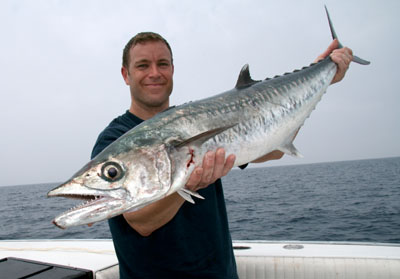Kingfish Action Abounds In Egmont Ship Channel
Main Artery Accessing Tampa Bay Loaded with Baitfish and Predators

Photo by David A. Brown |
By CAPT. BILL MILLER
I've been kingfishing all my life and I've caught these fish in many different areas and scenarios. However, on Florida's Central Gulf Coast, there's one place I can always count on – the Egmont ship channel.
The main navigational channel accessing Tampa Bay, “The Ditch,” as some call it, is a natural fish attractor because the current coming in and out of the bay carries loads of baitfish. Moreover, the cut of the channel creates tide rips and offers hiding places for those baitfish.
Kingfish also like the channel because they can chase baitfish up from the depths and onto the shallow edges. There's a reason they call it a food funnel and kingfish take full advantage of the feeding opportunities.
Follow these points to better kingfish action:
The Right Baits - The most common channel baitfish include cigar minnows, Spanish sardines, threadfin herring, scaled sardines and blue runners. You can catch live baits around the marker chains or around bait schools in the channel using Sabiki rigs. Drop the sabikis down by the markers or cast into the dimpling bait schools on top, and use whatever bait you catch.
Handy with Hardware - Stinger rigs are essential for preventing cutoffs. I build mine with a 2/0 short shank live bait hook on the front and a No, 4 treble trailer and I nose-hook the bait.
Twenty-pound monofilament is a good all-around choice for line on a conventional or spinning reel that can hold at least 250 yards. Braided line can work but the no-stretch factor might yank the hook out of a king’s mouth on the typical slashing strike. A medium to light tip on the rod will help improve your hook-up/catch ratio for the same reason.
The Hot Zone - The floating channel markers and their anchor chains are particularly attractive, so always check out the cans. Some of the best king areas start with markers 9-10 and continue all the way out to “The Whistler” – the last buoy going west.
Trolling Tactics - Once you reach your area, put out three or four baits at varying distances behind the boat and troll as slowly as your boat will go – about 1-2 mph on the GPS is right where you want to be. The idea is to make the swimming baits look as natural as possible.
Wind and tide will affect your trolling speed and you might have to bump up your rpm’s when going into the wind and tide to reach the optimal speed. Going down wind and down tide, use a controlled power drift by bumping your motor(s) in and out of gear.
Follow the Food - Baitfish schools always attract kingfish, so watch for surface activity and monitor your depth recorder for pods below. Once you find the bait, slow troll around the perimeter because that's where the kings will attack.
Near the markers, use a figure-8 pattern and cross the channel to troll around each buoy. If you find a particular buoy that is holding bait and kings, concentrate your efforts there.
If the markers you're fishing fail to produce, troll out to the next set. Often you'll find bait and kings in between the markers.
When word of a hot Egmont bite gets out, the ditch it can get crowded. Be courteous and give each boat ample space when trolling. There's plenty of fish, so cooperate with others and they'll return the favor when you hook your big kingfish.
For weekly fishing reports, hot tips, catch photos and lots of angling resources, visit www.billmiller.com. For fishing charters in the Tampa Bay area, call (813) 363-9927.

